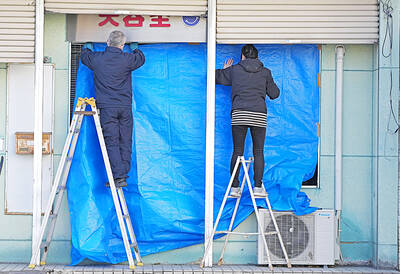Close to 300 aftershocks have been reported in Hualien following a couple of large earthquakes on Sunday, the Central Weather Bureau (CWB) said yesterday.
As of 3pm yesterday, 46 of the aftershocks were felt as earthquakes, which were between 3 and 4 on the Richter Scale, the bureau said.
CWB Seismology Center Director Kuo Kai-wen (郭鎧紋) said the phenomenon was called an earthquake sequence.

PHOTO: CNA
“The earthquake sequence happened because the large earthquake caused a bigger rupture near the epicenter, which in turn triggered seismic activity nearby and thus a series of aftershocks,” Kuo said.
“All these aftershocks, however, are a normal release of seismic energy,” Kuo said. “Both the frequency and the force of aftershocks have reduced since Sunday.”
Kuo said the earthquake sequence was not a new phenomenon in the nation’s seismic history. He also disagreed with statements that the aftershocks were a sign of a large earthquake to come.
Statistics from the bureau showed that the first earthquake of the series occurred in Hualien at 9:26am on Sunday, with the epicenter located about 15km northeast of the bureau’s observation station in Hsiulin (秀林). It measured 4.4 on the Richter scale and induced a couple of aftershocks.
Another earthquake measuring 5.6 occurred at 5:34pm, which was the second-biggest earthquake this year. After that earthquake, Hualien continued to feel aftershocks at a frequency of two to four every hour.
Seventeen aftershocks occurred between 1am and 2am yesterday, measuring between 3 and 4 on the scale. The biggest aftershock occurred at 1:44pm on Sunday, measuring at 4.9.
In related news, Taroko Gorge National Park announced yesterday that rock falls caused by the earthquakes had affected a number of walking paths in the park.
For the safety of visitors, park authorities decided from today to close the Jhueilu Historic Trail (錐麓古道), Changchun Shrine Trail (長春祠步道), Skadang Trail (砂卡礑步道) and Swallow Grotto Trail (燕子口步道) walking paths for two days.

Taiwanese were praised for their composure after a video filmed by Taiwanese tourists capturing the moment a magnitude 7.5 earthquake struck Japan’s Aomori Prefecture went viral on social media. The video shows a hotel room shaking violently amid Monday’s quake, with objects falling to the ground. Two Taiwanese began filming with their mobile phones, while two others held the sides of a TV to prevent it from falling. When the shaking stopped, the pair calmly took down the TV and laid it flat on a tatami mat, the video shows. The video also captured the group talking about the safety of their companions bathing

US climber Alex Honnold is to attempt to scale Taipei 101 without a rope and harness in a live Netflix special on Jan. 24, the streaming platform announced on Wednesday. Accounting for the time difference, the two-hour broadcast of Honnold’s climb, called Skyscraper Live, is to air on Jan. 23 in the US, Netflix said in a statement. Honnold, 40, was the first person ever to free solo climb the 900m El Capitan rock formation in Yosemite National Park — a feat that was recorded and later made into the 2018 documentary film Free Solo. Netflix previewed Skyscraper Live in October, after videos

Starting on Jan. 1, YouBike riders must have insurance to use the service, and a six-month trial of NT$5 coupons under certain conditions would be implemented to balance bike shortages, a joint statement from transportation departments across Taipei, New Taipei City and Taoyuan announced yesterday. The rental bike system operator said that coupons would be offered to riders to rent bikes from full stations, for riders who take out an electric-assisted bike from a full station, and for riders who return a bike to an empty station. All riders with YouBike accounts are automatically eligible for the program, and each membership account

A classified Pentagon-produced, multiyear assessment — the Overmatch brief — highlighted unreported Chinese capabilities to destroy US military assets and identified US supply chain choke points, painting a disturbing picture of waning US military might, a New York Times editorial published on Monday said. US Secretary of Defense Pete Hegseth’s comments in November last year that “we lose every time” in Pentagon-conducted war games pitting the US against China further highlighted the uncertainty about the US’ capability to intervene in the event of a Chinese invasion of Taiwan. “It shows the Pentagon’s overreliance on expensive, vulnerable weapons as adversaries field cheap, technologically